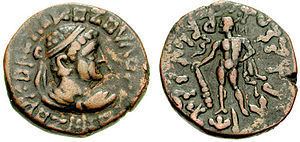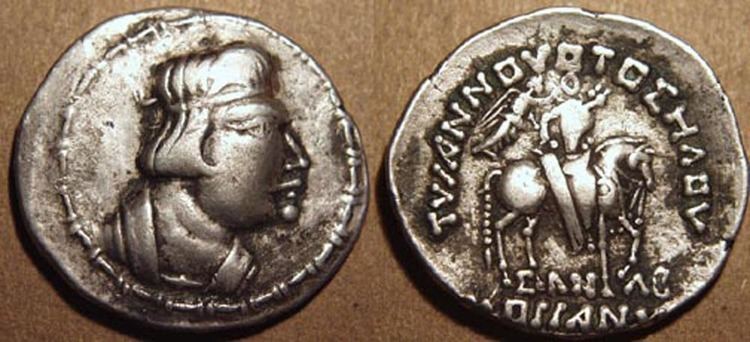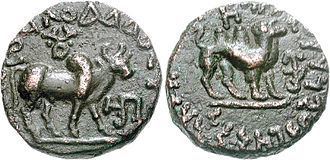Reign 30 CE - 80 CE Died 80 AD Name Kujula Kadphises | Children Sadashkana | |
 | ||
Kushana Kingdoms Coinage
Kujula Kadphises (Kushan language: Κοζουλου Καδφιζου, also Κοζολα Καδαφες; Kharoṣṭhī: Kujula Kasasa; Ancient Chinese: 丘就卻, Qiujiuque; reigned 30–80 CE, or 40-90 CE according to Bopearachchi.) was a Kushan prince who united the Yuezhi confederation during the 1st century CE, and became the first Kushan emperor. According to the Rabatak inscription, he was the great grandfather of the great Kushan king Kanishka I. He is considered as the founder of the Kushan Empire.
Contents
- Kushana Kingdoms Coinage
- History
- Chinese accounts
- Genealogy according to the Rabatak inscription
- Coinage
- Greek script
- Buddha coins
- Roman style coins
- References

History

The origins of Kujula Kadphises are quite obscure, and it is usually considered he was a descendant of the Kushan ruler Heraios, or possibly identical with him. Interestingly however, Kujula shares his name (Kushan: Κοζουλου on some of his "Hermaeus" coins, or Κοζολα on his "Augustus" coins) with some of the last Indo-Scythian rulers, such as Liaka Kusulaka (Greek: Λιακα Κοζουλο), or his son Patika Kusulaka, which might suggest some family connection.
Chinese accounts

The rise of Kujula Kadphises is described in the Chinese historical chronicle, the Hou Hanshu:

More than a hundred years later, the prince [xihou] of Guishuang, named Qiujiuque [Kujula Kadphises], attacked and exterminated the four other xihou. He established himself as king, and his dynasty was called that of the Guishuang [Kushan] King. He invaded Anxi [Indo-Parthia], and took the Gaofu [Kabul] region. He also defeated the whole of the kingdoms of Puda [Paktiya] and Jibin [Kapisha and Gandhara]. Qiujiuque [Kujula Kadphises] was more than eighty years old when he died.
In the process of their expansion eastward, Kujula Kadphises and his son Vima Takto seem to have displaced the Indo-Parthian kingdom, established in northwestern India by the Parthian Gondophares since around 20CE:
His son, Yangaozhen [probably Vema Tahk(tu) or, possibly, his brother Sadaṣkaṇa], became king in his place. He defeated Tianzhu [North-western India] and installed Generals to supervise and lead it. The Yuezhi then became extremely rich. All the kingdoms call [their king] the Guishuang [Kushan] king, but the Han call them by their original name, Da Yuezhi.
This invasion of Kujula Kadphises is thought to have occurred during the reign of Abdagases and Sases, the successors of Gondophares, after 45 CE.
Genealogy according to the Rabatak inscription
The connection of Kujula with other Kushan rulers is described in the Rabatak inscription, discovered in Rbatak, Afghanistan some years ago, which was written by Kanishka. Kanishka makes the list of the kings who ruled up to his time: Kujula Kadphises as his great-grandfather, Vima Taktu as his grandfather, Vima Kadphises as his father, and himself Kanishka:
And he [Kanishka] gave orders to make images of the same, (namely) of these gods who are written herein, and he gave orders to make (them) for these kings: for King Kujula Kadphises (his) great grandfather, and for King Vima Taktu (his) grandfather, and for King Vima Kadphises (his) father, and for himself, King Kanishka.
Coinage
Most of Kujula's coins were Hellenic or Roman in inspiration. Some coins used the portrait, name and title of the Indo-Greek king Hermaeus on the obverse, indicating Kujula's wish to relate himself to the Indo-Greek king. Since the Kushans and their predecessors the Yuezhi were conversant with the Greek language and Greek coinage, the adoption of Hermaeus cannot have been accidental: it either expressed a filiation of Kujula Kadphises to Hermaeus by alliance (possibly through Sapadbizes or Heraios), or simply a wish to show himself as heir to the Indo-Greek tradition and prestige, possibly to accommodate Greek populations. These coins bear the name of Kujula Kadphises in Kharoṣṭhī, with representations of the Greek demi-god Heracles on the back, and titles ("Yavugasa") presenting Kujula as a "ruler" (not actual king), and a probable Buddhist ("Dharmathidasa", follower of the Dharma). Later coins, possibly posthumous, did describe Kujula as "Maharajasa", or "Great King".
Greek script
The Greek script on the coins of Kujula (and all the Kushans with him) is barbarized. For example, ΣΤΗΡΟΣΣΥ on his Hermaeus coins is thought to be a deformation of ΣΩΤΗΡΟΣ (Sotiros), the traditional title of Hermaeus on his coins. The Greek word for "king" is written ΒΑϹΙΛΕΩΣ, with both a lunate sigma (Ϲ) and a normal sigma (Σ) in the same word.
The Kushans also added one character to the Greek script: it is the letter Ϸ, corresponding to the sound "Sh", as in "Kushan".
"Buddha" coins
Some coins of Kujula also represent a cross-legged seated figure, formerly said to be one of the first known representations of the Buddha on a coin (Whitehead). Unfortunately, Whitehead's attribution of this coin to Kujula, and the claim that the seated figure on the obverse represents the Buddha, is now known to be incorrect. The correct attribution of this coin is to the Kushan king Huvishka, who was Kujula's great-great-grandson. The obverse shows Huvishka seated on a couch. The first known coins carrying a representation of the Buddha were issued by Kujula's Great-grandson (and Huvishka's father) Kanishka I.
Roman-style coins
Some fewer coins of Kujula Kadphises also adopted a Roman style, with effigies closely resembling Caesar Augustus, although all the legends were then associated with Kujula himself. Such influences are linked to exchanges with the Roman Empire around that date.
